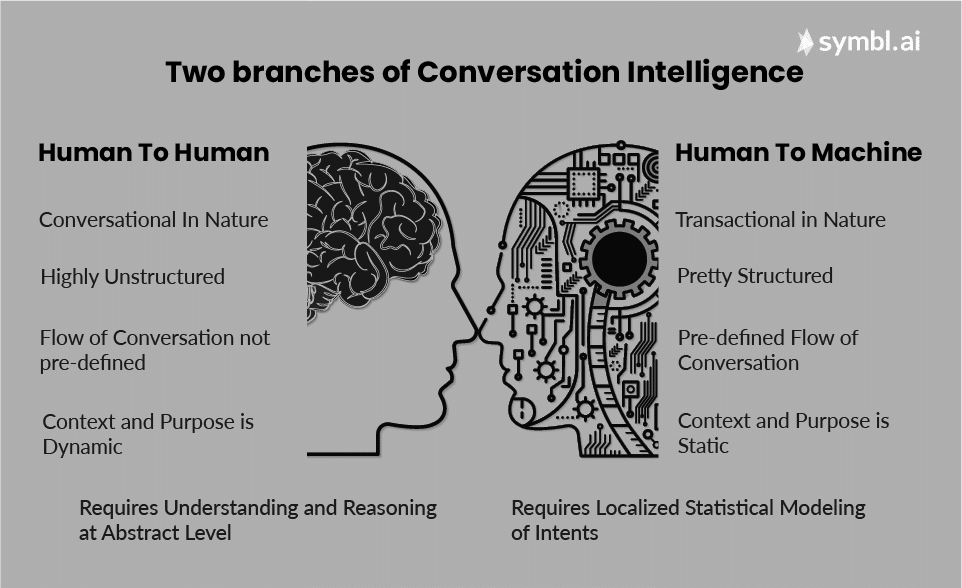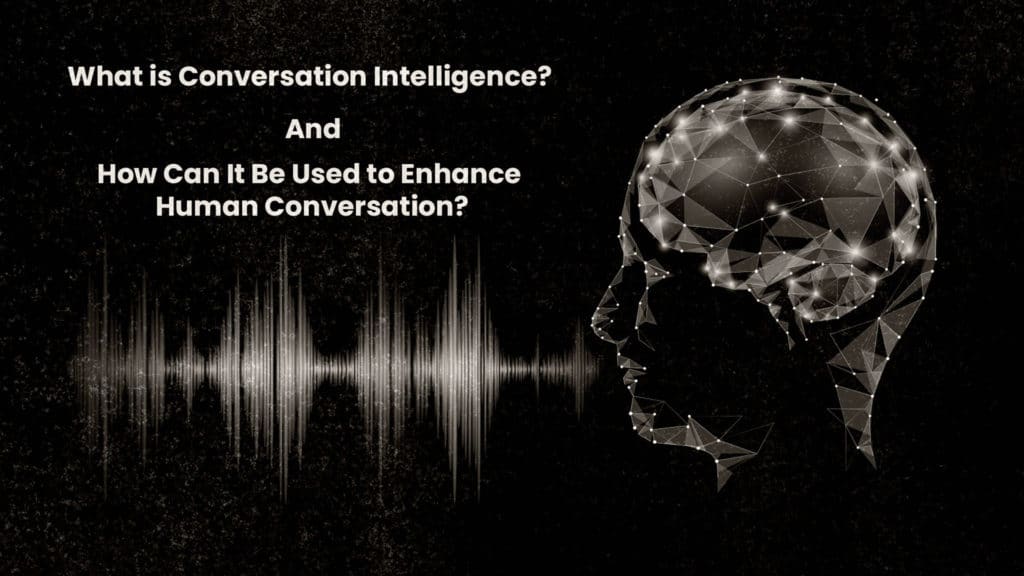Conversation intelligence provides the ability to analyze natural human-to-human conversations in real-time. Going beyond simple natural language processing of voice and text conversations, mission-critical communications can be harnessed, analyzed, and optimized.
Data flowing through digital communication channels
Today, cloud communication products and workflows enable businesses to have conversations over multiple, secure digital channels. Machine learning systems can use conversation intelligence: a specialized form of AI which takes business communication experience to the next level.
You can build conversation intelligence for one-to-one or multi person conversations contextually. Businesses can build features and experiences into the system, empowering an ability to generate shared knowledge and outcomes to get the most out of their conversations.
Using machine learning to enhance the conversation
When you’re in a conversation with another human, AI can assist by analyzing speech patterns in real-time. A conversation intelligence system can undertake speaker separation and identification. You can leverage this for several types of customer conversations where it’s important to optimize engagement and amplify the interaction. For example you can:
- Use models for emotional analysis – the conversation intelligence can recognize speakers’ current mood and any mood changes. In a call centre this helps agents avoid making a bad situation worse and lets them wrap up calls quicker and to the callers’ satisfaction.
- Take care of tasks that humans don’t need to be involved in – like scheduling meetings, or sending task reminders.
- Translate in real-time
When conversation intelligence is continually used the AI keeps learning and gets smarter. This means the system you build will get more and more useful. For example, you can use previously collected data; like a backlog of customer problems, including conversations and solutions from your voice calls; to train your AI to answer FAQs right there in the phone queue or divert certain topics to specialist operatives.
You can also build new conversation intelligence systems for your call recordings if they are stored on stack. These can be used to audit the calls for specific purposes, such as to find keyword phrases, redact sensitive data, or identify coaching opportunities.
You can use some off-the-shelf conversation AI APIs or open-source models to build this system on both voice and text data asynchronously. Symbl offers Async APIs on voice and video text that can be used to aggregate insights and analyze conversation with several aspects in offline mode:
- Meta-data like speakers, contact information, title of the conversation.
- All members, transcripts and messages in the conversation as well as the topics discussed.
- Any questions or requests for information that went unanswered in the call with identified speakers.
- Appointments or follow ups.
You can read more here about applying machine learning to voip systems.
Intelligence for human-to-human conversations
Human to human conversation (H2H), whether two-party or multi-party interaction, becomes highly unstructured and fragmented in almost any context (business, social, etc.). In contrast to the understanding of spoken utterances directed at machines (human to machine (H2M) conversation), the H2H conversation relies heavily on a sophisticated pre-built conceptual understanding of the world together with an innate language instinct. The combination of these allows for unstructured conversation flow and context disambiguation. As a result, in contrast to H2M conversations, H2H conversations are very rich and unstructured, filled with ideas and multiple concepts interlinked together.

Naturally, this means that the same intelligence that’s built for understanding narrow commands or wake words (e.g. “Hey Siri”, “Alexa”, and “OK Google”) is neither compatible nor sufficient to make sense out of the conversations where human beings are talking to each other. Symbl.ai is built to address that need – to provide intelligence specifically for H2H conversations.
Why talking with a human will never go away
H2H and H2M are the two main branches of conversation AI. Smart devices with digital voice assistants, such as Alexa and Siri, or applications built with platforms like DialogFlow) can process and recognize what humans are saying to them, but they are usually built to support narrow use cases that are transactional in nature and are not able to understand and capture knowledge when there are more than two humans. While there is currently an enormous amount of investment in the research necessary to make machines capable of understanding human language, most of the use cases and applications on the market today are limited to a basic mapping of the statistical modeling of the right intents and the response to it.
The H2H branch of CI is vital for unstructured human conversations and can allow your application to:
- Gain a general understanding of the world and be able to relate to it.
- Build abstract knowledge over time.
- Reason with its understanding and learning within the context of the current dialog.
For example, when booking a flight with an agent, your application could derive insights related to where you want to go and recommend a plan for your itinerary. This would be a completely different conversation with a machine as it would focus only on the set of questions, intents and actions that it is trained for. It would not be capable of engaging in a real conversation with you to understand your individual needs to dynamically propose the best solution.
Conversation intelligence is the new superpower
Conversation is a vital part of human interaction. Symbl has learned that on average each person communicates around 10,000,000 words per year. That’s a lot of information!
It goes without saying that your business clients have mission-critical communications, and so the ability to harness, analyze, and optimize their power is crucial. Symbl.ai is a developer platform for H2H conversation intelligence and allows you to build your experience without any need to build or train a machine learning model.
WIth contextual AI for H2H conversations you can build a cutting-edge (and very cool) intelligence that actually hears what you’re saying, communicates, and allows you to identify and recommend solutions in a more natural, intuitive, and sophisticated way – with intelligence that is passively embedded in all communication workflows. Using the previous example of booking a flight, with contextual AI, you can explain a practical problem with changing your flight, including your reasons, and the system will understand the context and provide a solution.
Conversation intelligence products
Symbl.ai, is a platform that can be used to develop and/or enhance any vertical or use case specific application. However there are other technologies that have been developed to address the need for conversation intelligence in very specific use cases. Here are a few examples:
- Chorus.ai and Gong.io are conversation AI tools providing insights for sales and service organizations. They can record, transcribe, and analyze meetings and calls.
- CallMiner and Uniphore provide speech analytics and interaction analytics CI software for use in call centres.
- Tethr has been developed to ensure compliance by providing conversation AI insights into calls and also manage risk, provide an audit trail and redact sensitive information.
- Talview and Hirevue use conversation AI software in recruitment interviews conducted remotely by video and phone.
Conversation intelligence APIs
A conversation intelligence API is generally defined as a web service that can be used by developers and which is capable of contextually analyzing natural conversations between two or more humans. This service can understand the meaning of the conversation instead of requiring keywords or wake words as digital voice assistants and chatbots do.
Conversation intelligence can augment human capability by surfacing many things that matter in real time, including questions, action items, insights, contextual topics, and signals. A conversation intelligence API provides an extensible interface that developers can use to consume the contextual AI capabilities in their preferred communication interface.
Symbl is a conversation intelligence platform that provides real time and contextual AI capabilities, with a secure and scalable infrastructure, and programmable APIs and SDKs for developers. This enables businesses to get their products to market faster and without investing resources in building their own real time ML. infrastructure. They can focus instead of building differentiated pre/in/post conversation experiences.
Learn how to build a conversation intelligence system in our next post in this series.
Further reading:
- Symbl.ai – What Does a Conversation Intelligence API Offer My Company
- Symbl.ai – A Developer Platform for Conversation Intelligence
- Benefits of Conversational AI
- Conversational AI
- Business collaboration: Real time V’s Asynchronous
- https://docs.symbl.ai/docs/async-api/overview/introduction/
- Contextual Disambiguation
